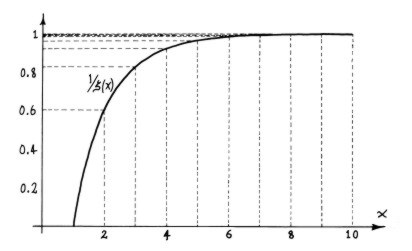

where μ(n) is the Möbius Function which we encountered earlier. Recall that it is defined on the natural numbers as follows:
μ(n) equals zero when n is divisible by a square, and otherwise equals (–1)k where k is the number of distinct prime factors in n.
For example,
μ(42) = (–1)3 = –1 as 42 = 2 × 3 × 7
μ(55) = (–1)2 = 1 as 55 = 5 × 11.
μ(242) = 0, as 242 is divisible by 121 = 112.
In this way, 1/ζ(x) acts as a "generating function" for the arithmetic information associated with the function μ(n). Other functions constructed from ζ have similar properties. Three examples:
(i) ζ(x)/ζ(2x) generates the sequence of values {|μ(n)|} as follows:
(ii) log ζ(x) generates the sequence of values {l(n)} where l(n) is defined to be 1/k when n = pk and to be zero otherwise:
(iii) –ζ '(x)/ζ(x) generates the sequence of values {Λ(x)} where Λ(n)(x) (the von Mangoldt function) is zero unless n is a power of a prime p, in which case it takes the value log p: